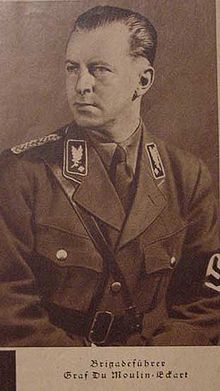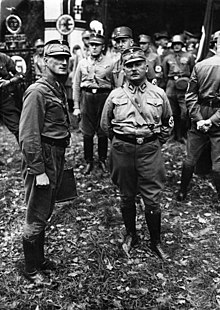Karl Leon Du Moulin-Eckart
Karl Leon Eduard Friedrich Bernhard Max Count Du Moulin Eckart (born January 11, 1900 in Munich , † March 31, 1991 in Oberviechtach ; also Carl-Leon Du Moulin-Eckart ) was a German politician ( NSDAP ) and SA leader . He was best known as the head of the SA's intelligence service from 1930 to 1932.
Live and act
Youth and Weimar Republic
Du Moulin Eckart was born as the third child and only son of history professor Richard Count Du Moulin Eckart (1864-1938) and his wife Bertha (born July 18, 1866 in Coburg; † March 5, 1949 in Bertoldsheim; née Berger). After participating in the First World War he was part of the Epp Freikorps , where he met Ernst Röhm . From February to October 1923, Du Moulin worked as a dispatcher at Faber. In November 1923 he took part in the Hitler putsch in Munich. Together with Röhm, Heinrich Himmler and a few others, he occupied the former Bavarian War Ministry that day . In addition, Du Moulin provided courier services during the coup, as an orderly liaising between the various departments of the coup plotters.
This was followed by the study of law , which he 1927 with the promotion of Dr. jur. completed. His doctoral thesis was devoted to the espionage and its treatment by international law and empire-criminal with special consideration of the draft to a general German criminal code from 1927 . When, after the death of an uncle you Moulins father as Majoratsherr the family estates in Winklarn and Bertoldsheim took, you took Moulin manage them.
Career in the SA (1931 to 1934)
When Ernst Röhm was appointed chief of staff of the SA at the beginning of 1931, he brought Du Moulin Eckart to his staff in the SA leadership. b. V. and later as head of subdivision Ic (intelligence service). Du Moulin Eckart, who was appointed SA Oberführer with effect from February 1, 1932, held this position, which he carried out from an office in the Brown House in Munich, until the SA and SS were banned across the Reich on April 13, 1932. The management was done by the Munich SS man Max Frauendorfer .
After the SA ban was lifted on June 14, 1932, Du Moulin Eckart was from July 1 to September 30, 1932 a consultant in the group staff z. b. V. of the Supreme SA leadership . Subsequently, from October 1, 1932, he was transferred from the staff of the Supreme SA leadership to the SA group Austria, where he was leader of the SA sub-group Vienna until April 19, 1933. From April 20, 1933 he was "on leave until further notice" before he was transferred on September 25, 1933 to join the SA group in Saxony. Until July 1, 1934, Du Moulin Eckart was SA leader z. b. V. of the SA group Saxony. Here he was promoted to SA brigade leader on November 9, 1933 on the occasion of the tenth anniversary of the coup.
In the forged letters of the Münchner Neue Post on June 24, 1931, Du Moulin Eckart was named together with Rolf Reiner as one of the leading homosexual SA men. He was also accused of being "the most disgusting in the whole Brown House because of his decidedly feminine attitude" for First Lieutenant a. D. Brückner to be. In the spring of 1932, Walter Buch , the highest party judge of the NSDAP , planned the assassination of Du Moulin Eckart, Röhm, his adjutant Spreti-Weilbach , Bell and Uhl , because he feared that their homosexuality , which was generally known to the public, would result in the upcoming elections could prove to be a political mortgage, which means that many potential voters could withhold their votes out of disgust for the “unnatural tendencies” of the Röhm clique of the NSDAP. He gave the bankrupt bandage manufacturer and Nazi spy Emil Traugott Danzeisen the order to take over the murder. The latter in turn passed the order on to the former architect Emil Karl Horn in a letter. Horn shrank from it and informed Du Moulin Eckart. In the subsequent "Danzeisen Trial", he was sentenced to six months' imprisonment.
In the 1936 exile novel Before great changes by the communist Ludwig Renn , where the SA is portrayed as a brutal group of men in which adolescents are systematically raped, Du Moulin Eckart is portrayed as a close friend of Wolf-Heinrich von Helldorff and Edmund Heines . With those and others who "had achieved something through the bed of Chief of Staff Röhm or hoped to achieve something", he talked about the "Dutch hustlers" in an adjoining room of the Horcher wine bar on Lutherstrasse near Berlin's Wittenbergplatz. Marinus van der Lubbe in order to instigate an arson attack on the Reichstag building . With this, Renn transferred the cliché of the “homosexual fascist” and criminal to Du Moulin Eckart and contributed to solidifying the stereotype. (→ homophobia among leftists )
Persecution and Later Life
In the summer of 1934, after his arrest on the evening of June 30, 1934 in Wiesbaden, Du Moulin accidentally escaped the murder in the course of the " Röhm Putsch ". According to Dornbach, the reason for this can probably be seen in his personal friendship with Heinrich Himmler , who orchestrated the murder. In contrast, Du Moulin reported in his résumé that Himmler later said to him: “You were lucky, you came to Berlin too late to be shot.” During the Nuremberg trials , Hermann Göring testified that Hitler was actually on Du Moulin- Eckart was "particularly angry" and ordered his shooting , but that he got away with a concentration camp , since the shootings of June 30th / 1st. July 1934 after they got out of hand, whereby Du Moulin-Eckart was lucky enough to be alive at the time the order was issued to stop the shootings.
Hitler himself declared when Winifred Wagner stood up for his son at the request of Du Moulin-Eckart's father: “Don't ask for this fellow. He's the worst of them all. ”The dictator justified this with the fact that before 1933 the young Du Moulin had betrayed Nazi party secrets to the Social Democrats.
In autumn 1934, Du Moulin-Eckart, as Röhm's former adjutant, was one of four defendants in a trial before the Munich District Court in connection with Ernst Röhm's homosexuality. The other defendants were Röhm's former personal servant Holtsch, his friend Prosch and a certain Peter Granninger, who had acted as a kind of private pimp of Röhm. In this trial, Du Moulin was accused of aiding and abetting unnatural fornication ( Section 175 of the Criminal Code ) because in 1931 and 1932 he had repeatedly made his Munich apartment available for encounters with young people with whom Röhm had committed homosexual acts there. Because Du Moulin, who stated that Röhm had asked him to make his apartment available to him for the execution of confidential promises and that he did not know that Röhm had committed homosexual acts instead of secretly holding political or other important conversations there (he himself was never present when Röhm met with third parties in his apartment), it could not be proven that he knew about Röhm's illegal "activities" according to the legal situation at the time, he was finally acquitted .
Instead of being set free Du Moulin was after the Munich process from the political police in protective custody taken. He was imprisoned in Lichtenburg concentration camp until 1936 . He was later transferred to the Dachau concentration camp , where he was held until 1936. During his imprisonment he was under the personal protection of his old friend Heinrich Himmler.
Du Moulin-Eckart then had himself certified by a court that he did not belong to the homosexuals and withdrew from public life.
family
On March 28, 1944, Du Moulin-Eckart married Erika Schmaeling (born September 25, 1911 in Memel), from whom he divorced in 1949. The son Carl-Marcel (* / † Schloss Winklarn March 25, 1945) emerged from the marriage, who died in childbed.
In his second marriage, Du Moulin married the internist and psychotherapist Eva Kusche on March 9, 1954 (born July 27, 1925 in Munich; † April 8, 2020 in Munich). From this marriage, the daughters Constanze-Irmingard Aimée Elisabeth Charlotte Anna Maria Mathilde (born October 11, 1954 in Munich) and Maja-Christine Agathe Antonia Mimi Theodora Yanka Ina (born July 24, 1956 in Munich) were born.
Du Moulin-Eckart also had another child from an extramarital relationship (* 1931/1932).
In 2008 the widow sold Bertoldsheim Palace with all its inventory.
estate
A collection of Heinrich Himmler's material on Du Moulin-Eckart is kept in the Federal Archives (NS 19/882). The Institute for Contemporary History has its ruling chamber file (IfZ: G, Sp 2/1). In addition, there are files relating to a procedure for pimping and unnatural fornication that took place in Munich in September 1934 (judgment of September 13, 1934; VII 3343-53 / 43 Munich I). An investigation report from January 28, 1952 (1 Js. Gen 1 ff / 49) is at the Institute for Contemporary History (G 07.95)
Fonts
- The spy and their treatment under international law and criminal empire-German with special consideration of the draft to a general criminal code from 1927 , Coburg 1928. (Erlangen University, Dissertation, 1929).
Individual evidence
- ↑ Cf. Heinz Höhne : The order under the skull. The history of the SS. Mohn, Gütersloh 1967, p. 71 ff.
- ↑ a b c Bernd-Ulrich Hergemöller : Man for man . A biographical lexicon (= Suhrkamp-Taschenbuch 3266). Suhrkamp, Frankfurt am Main 2001, ISBN 3-518-39766-4 .
- ^ Andreas Dornheim : Röhm's husband for abroad. Politics and murder of the SA agent Georg Bell (= story, 18). LIT, Münster et al. 1998, ISBN 3-8258-3596-0 , p. 288.
-
↑ Göring's statement before the Nuremberg court on March 18, 1946, in: IMT, vol. X, p. 485f. ( Digitized version ).
Irving: Göring, p. 216 also cites a statement by Göring that the executions were ended because of his recommendation to Hitler to stop them, "although two personal enemies of the Führer, von Alvensleben and Moulin-Eckart escaped with their lives". - ↑ Brigitte Hamann: Winifred Wagner, or, Hitler's Bayreuth , 2002, p. 282.
- ↑ Dietmar Schulze: The "Röhm Putsch" in the province of Saxony. In: Halle contributions to contemporary history. Issue 15, 2005, ISSN 1433-7886 , pp. 9-33, online (PDF; 578 kB) .
- ↑ Bernd-Ulrich Hergemöller: Mann for Mann , Berlin 2010, p. 273.
- ↑ Burkhard Jellonnek: homosexuals under the swastika. The persecution of homosexuals in the Third Reich. Schöningh, Paderborn 1990, ISBN 3-506-77482-4 , p. 70, note 50.
- ^ Andreas Dornheim: Röhm's husband for abroad. Politics and murder of the SA agent Georg Bell (= history. Vol. 18). LIT, Münster et al. 1998, ISBN 3-8258-3596-0 , pp. 53f., 123-135.
Web links
- Literature by and about Karl Leon Du Moulin-Eckart in the catalog of the German National Library
| personal data | |
|---|---|
| SURNAME | Du Moulin-Eckart, Karl Leon |
| ALTERNATIVE NAMES | Du Moulin Eckart, Karl Leon Eduard Friedrich Bernhard Max Graf |
| BRIEF DESCRIPTION | German SA leader |
| DATE OF BIRTH | January 11, 1900 |
| PLACE OF BIRTH | Munich |
| DATE OF DEATH | March 31, 1991 |
| Place of death | Oberviechtach |


